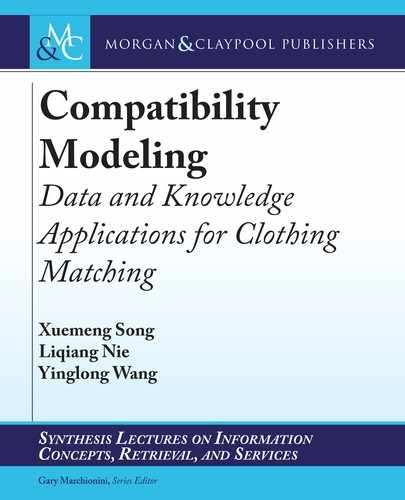68 6. PERSONALIZED COMPATIBILITY MODELING
6.3.3 PERSONAL PREFERENCE MODELING
As for the personal preference modeling toward a bottom, we resort to the matrix factorization
framework, which has shown great success in personalized recommendation tasks [2, 56, 60, 92].
e underlying philosophy is to decompose the user-item interaction matrix into the latent user
factors and item factors, whose inner products encode the user-item interaction scores. In our
context, we model the user preference toward a bottom as follows:
c
mj
D ˛ C ˇ
m
C ˇ
j
C
T
m
j
; (6.5)
where c
mj
represents the preference of user u
m
for bottom b
j
. ˛ is the to-be-learned global offset,
and ˇ
m
and ˇ
j
are the user u
m
and bottom b
j
bias terms.
m
and
j
are the latent factors of
user u
m
and bottom b
j
, respectively, whose inner product captures the latent preference of user
u
m
for the bottom b
j
.
Apart from the latent overall preference factors, inspired by [34], we also incorporate the
latent content-based preference factors. e philosophy behind lies in that the user preference
for a fashion item may come from the visual characteristics, like the color and shape, or the
contextual features, like the brand and material. Different from [34], we take into account of not
only visual modality but also contextual modality of fashion items to comprehensively measure
the user-item interactions. Accordingly, incorporating the latent visual and contextual preference
factors to the matrix factorization framework, we have c
mj
D
˛ C ˇ
m
C ˇ
j
C
T
m
j
C
v
m
T
v
j
C .1 /
c
m
T
c
j
; (6.6)
where
v
m
and
v
j
are the latent visual factors of user u
m
and bottom b
j
, respectively. e in-
ner product between them conveys the visual preference interaction between the user u
m
and
bottom b
j
. Similarly,
c
m
and
c
j
stand for the latent contextual factors of user u
m
and bottom
b
j
, respectively, which compile the contextual preference interaction. In this work, we make
v
j
D Qv
b
j
and
c
j
D Qc
b
j
, where Qv
b
j
and Qc
b
j
are the latent embeddings for the visual and contextual
representations of bottom b
j
. is the non-negative tradeoff parameter.
6.3.4 OPTIMIZATION
To accurately model the implicit interaction among users and fashion items (i.e., tops and bot-
toms), we adopt the BPR framework, which has proven to be powerful in the pair-wise implicit
preference modeling [6, 78, 82]. In particular, we first construct the following training set D WD
˚
.m; i; j; k/ju
m
2 U ^ .t
i
; b
j
/ 2 O
m
^ b
k
2 Bnb
j
; (6.7)
where the quadruplet .m; i; j; k/ indicates that to match the given top t
i
and make a proper
outfit, the user u
m
prefers the bottom b
j
to b
k
. en according to the BPR loss [100], we thus
..................Content has been hidden....................
You can't read the all page of ebook, please click here login for view all page.
